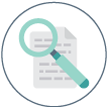When companies gain control of their data, they unlock a host of business benefits, from reducing risk to driving decision making. A robust data governance program involves a continuous process that evolves with the organization’s data landscape. Collaboration and clear communication throughout the stages of a data governance lifecycle will help ensure success.
Data governance truly involves a cyclical process, and organizations must revisit the stages periodically as data sources and business processes change. While various regulatory environments and business needs involve unique approaches, this post outlines the stages of a standard data governance lifecycle.
1. Define the Purpose and Goals
Any successful data governance program starts with an assessment of the current data and regulatory landscape. While technologies and trends support data governance, strategic planning should focus on identifying existing risks and business priorities.
For instance, for many organizations regulatory compliance needs provide the initial motivation for gaining control of data assets. Another key driver might include improving data quality to support AI initiatives or other innovations.
Whatever the motivation, an initial step will involve identifying risks and practices that present obstacles to attaining business goals. For example, insufficient data security will compromise regulatory compliance. And poor data quality will reduce the effectiveness of decision making and AI initiatives.

2. Build a Roadmap
With an understanding of the reasons and goals for data governance in the organization, it is time to put together a detailed plan. Begin by identifying the data elements throughout the organization. Look at the types of data collected, the data sources and data owners, and how the organization uses the data.
Next, assess the quality of the organization’s data. Several factors affect data quality. For example, outdated or redundant data will reduce the accuracy of data-driven decision making. Likewise, incomplete data will diminish the reliability of data analytics. And inconsistencies across systems and processes can lead to confusion and errors.
Once you have a detailed picture of the data landscape and the challenges involved, you can construct a data governance plan. This strategic plan will include identifying the steps needed to implement data governance, the key stakeholders, necessary resources, and priorities.
3. Design the Data Governance Strategy
Primary goals of the data governance framework involve establishing standards for data management. They also involve ensuring data security and empowering employees throughout the organization to find and use data effectively.
First, the data governance framework will include determining data governance roles and responsibilities. Properly managing data involves input from stakeholders throughout the organization. Some common roles include data governance sponsors and council, data owners, data custodians, data stewards, and data users.
Next, comprehensive policies and procedures around data access, usage, management, and security form the backbone of a data governance framework. For instance, regulations like PCI DSS and HIPAA impose strict rules around data retention. And numerous privacy laws necessitate security policies to protect sensitive data.
4. Implement the Data Governance Program
With policies and procedures outlined and strategies documented, the real work begins. Technology can play a crucial role in this process. For example, automation can significantly reduce the time involved in labeling and tracking sensitive data. Likewise, automating data retention and destruction policies improves accuracy and defensibility.
Technology solutions can both reduce risk and save time. These solutions will include proactive data security, data compliance monitoring, and comprehensive records management, along with eDiscovery solutions that provide essential visibility into unstructured data.
Additionally, the data governance program must address the human factor, building a culture of data governance from top to bottom. Thus, the program necessarily includes educating and training stakeholders about data governance policies and procedures and their role in maintaining data integrity.

5. Continuously Monitor
Data governance requires continuous monitoring to ensure enforcement of data governance policies and proactively identify risks. This includes both regular audits and automated data compliance monitoring.
6. Review and Adapt
The final stage involves evaluating the effectiveness of data governance initiatives and refining processes and policies accordingly. As new data sets and security risks emerge, and as processes within the organization change, the data governance framework will need to change, as well.
Conduct regular reviews with senior executives and key stakeholders. Track progress against key objectives, measure results, and make any needed adjustments.
Leverage Expert Resources Throughout the Stages of a Data Governance Lifecycle
Many organizations effectively utilize information governance solutions to streamline the data governance process. Working with organizations like eMazzanti Technologies and Messaging Architects provides access to both extensive expertise and cutting-edge technologies.
eGovernance Cloud Solutions
eGovernance is a Cloud based solution for preserving, discovering and accessing digital data within your email and document storage systems for compliance, audit, security, eDiscovery and warehousing of critical or older data.



